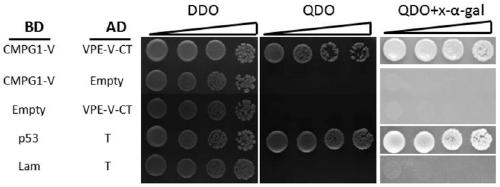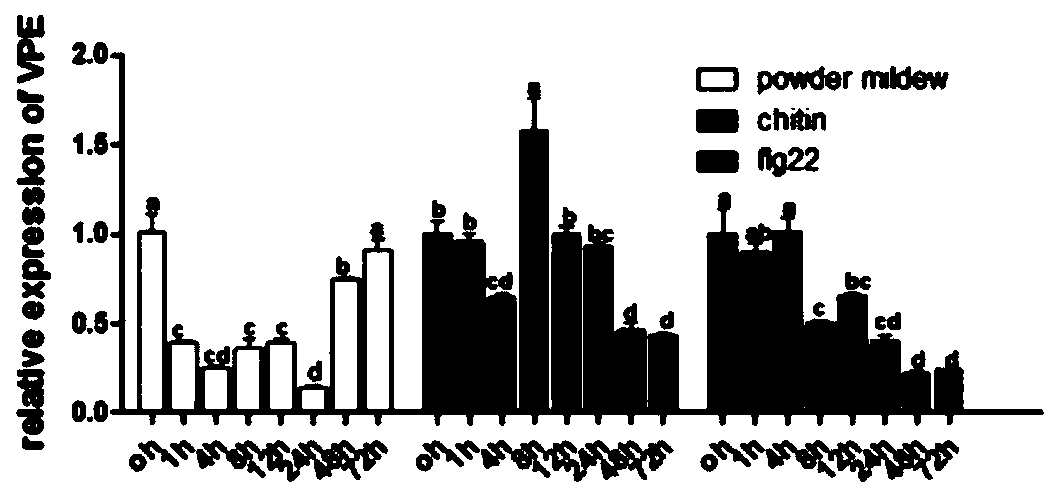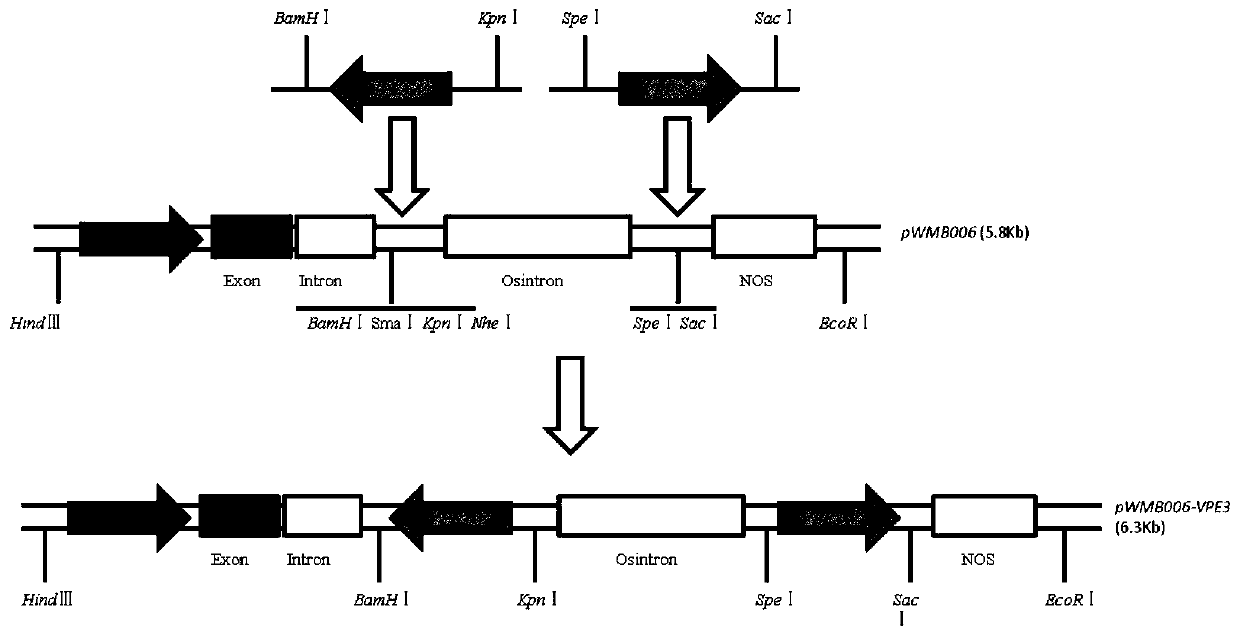Haynaldia villosa vacuolar processing enzyme gene VPE3-V and its silencing vector and application thereof
A technology of tufted wheat and enzyme gene is applied in the field of tufted wheat vacuole processing enzyme gene VPE3-V and its silencing vector, which can solve the problems of unclear disease resistance mechanism and the like
- Summary
- Abstract
- Description
- Claims
- Application Information
AI Technical Summary
Problems solved by technology
Method used
Image
Examples
Embodiment 1
[0025] Example 1 Utilize yeast two-hybrid screening CMPG1-V interacting protein, and clone VPE3-V gene
[0026] Dust wheat (Haynaldia villosa L.2n=14, VV) is an annual or perennial cross-pollinated wild relative of wheat, resistant to powdery mildew, rust, shuttle mosaic, take-all, spikelet number Excellent traits such as polysaccharides, drought tolerance and high grain protein content (Chen et al., 2013; Fu et al., 2017; He et al., 2017). In 2015, Zhu et al. cloned CMPG1-V located on 6V from A. pilosa, which played a role in powdery mildew resistance (reference: Zhu, Y. et al. E3 ubiquitin ligase gene CMPG1-V from Haynaldia villosa L. contributes to powdery mildew resistance in common wheat (Triticum aestivum L.). The Plant Journal. 2015.84, 154-168). In order to explore the mechanism of CMPG1-V-mediated powdery mildew resistance, using CMPG1-V as bait, the yeast two-hybrid cDNA library was screened by polyethylene glycol-lithium acetate transformation method, and an intera...
Embodiment 2
[0027] Example 2 The expression characteristics of VPE3-V gene induced by powdery mildew
[0028] T. villosa (Haynaldia villosa, accession no. 91C43, genome VV, 2n=14) was introduced from Cambridge Botanic Garden, UK by our laboratory. Sow the seeds of the powdery mildew-resistant wheat strain 91C43 (references: Qi Lili, Chen Peidu, et al., New source of resistance to powdery mildew in wheat—gene Pm21, Acta Crops, 1995, 21(3):257-262) Germinate in a dish, then orderly transfer to a 15 cm diameter petri dish covered with filter paper, continue to grow until the roots and leaves are about 3-5 cm, and then transfer to a 100-hole box for water cultivation, the culture condition is 20-23 ℃, 14h light / 10h dark, humidity 70%, pay attention to changing water during the period. When T. villosa grows to the three-leaf one-heart stage, select plants with basically the same growth state, and inoculate mixed powdery mildew with mixed powdery mildew, spraying chitin with a concentration of...
Embodiment 3
[0030] Example 3 Construction of VPE3-V gene RNAi silencing vector
[0031] Using the C. villosa cDNA induced by powdery mildew as a template, the primer pair P5 (CGGGATCCTTCCGCTATCGCTGCTGCTCCT, SEQ ID NO.8) and P6 (GGGGTACCTAGTTCTGGTAGCCGTTGGA, SEQ ID NO. .9) Carry out PCR amplification, and recover the amplified fragment. Insert the amplified target fragment into the vector pWMB006 by double digestion with BamHI and KpnI (references: Jefferson RA, Kavanagh TA, Bevan MW. GUS fusions: beta-glucuronidase as a sensitive and versatile genefusion marker in higher plants. EMBO J.1987 , 6:3901-3907) between the multiple cloning site BamHI and KpnI behind the Ubiquitin promoter; with the primer P7 (CGAGCTCTTCCGCTATCGCTGCTGCTCCT, SEQ ID NO.3) that can specifically amplify the VPE3-V gene fragment (SEQ ID NO.3). 10) and P8 (GACTAGTTAGTTCTGGTAGCCGTTGGA, SEQ ID NO.11) were amplified by PCR, and the amplified fragment was recovered. The amplified target fragment was inserted between the...
PUM
 Login to View More
Login to View More Abstract
Description
Claims
Application Information
 Login to View More
Login to View More - R&D
- Intellectual Property
- Life Sciences
- Materials
- Tech Scout
- Unparalleled Data Quality
- Higher Quality Content
- 60% Fewer Hallucinations
Browse by: Latest US Patents, China's latest patents, Technical Efficacy Thesaurus, Application Domain, Technology Topic, Popular Technical Reports.
© 2025 PatSnap. All rights reserved.Legal|Privacy policy|Modern Slavery Act Transparency Statement|Sitemap|About US| Contact US: help@patsnap.com



